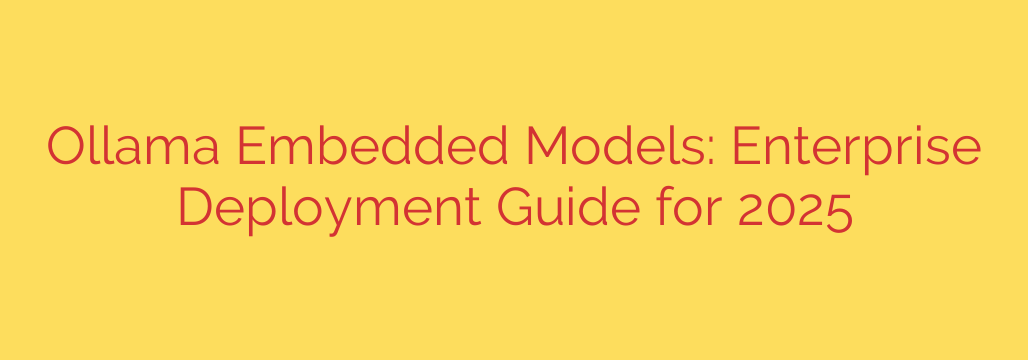
Enterprise-Ready AI: Your Guide to Deploying Ollama Models Securely
The enterprise landscape is rapidly embracing the power of Large Language Models (LLMs), but a critical question looms over every deployment: how do we leverage AI without compromising data security, cost controls, and operational independence? While cloud-based APIs offer convenience, the future for many organizations lies in self-hosted, private AI. This is where frameworks like Ollama are becoming indispensable, offering a streamlined way to run powerful open-source models directly on your own infrastructure.
Deploying Ollama in an enterprise environment, however, requires more than a simple installation. It demands a strategic approach focused on security, scalability, and integration. This guide outlines the essential considerations and best practices for a successful enterprise-grade Ollama deployment.
Why Local LLMs are Gaining Traction in the Enterprise
The shift toward self-hosting AI models is driven by several compelling business advantages that directly address the shortcomings of public AI services.
- Enhanced Data Privacy and Security: This is the most significant benefit. When you run models locally with Ollama, your proprietary data, customer information, and internal queries never leave your network. This eliminates the risk of third-party data breaches and ensures full compliance with regulations like GDPR, HIPAA, and CCPA.
- Significant Cost Savings at Scale: Public LLM APIs operate on a pay-per-token model. For high-volume applications, these costs can quickly become exorbitant and unpredictable. By investing in on-premise hardware, you move from a variable operational expense to a fixed capital expense, leading to a much lower total cost of ownership over time.
- Unmatched Customization and Control: Self-hosting gives you complete control over the AI stack. You can fine-tune open-source models on your company’s internal data to create highly specialized, domain-specific AI assistants. This level of customization is simply not possible with generic, one-size-fits-all public APIs.
- Improved Performance and Reliability: By eliminating network latency to an external provider, local models can offer faster response times for real-time applications. Your AI services also become immune to third-party outages or API changes, ensuring greater operational stability.
Key Considerations for Enterprise Ollama Deployment
Before launching an enterprise-wide deployment, a thorough planning phase is critical. Address these key areas to build a robust and scalable foundation.
1. Infrastructure and Hardware Provisioning
Running LLMs is computationally intensive, and the primary bottleneck is often GPU memory (VRAM).
- Hardware Selection: Assess the models you plan to run. Smaller models (7B parameters) may run on consumer-grade GPUs, but enterprise applications will likely require data center-grade GPUs like NVIDIA’s A100 or H100 series for optimal performance and concurrent user support.
- Virtualization and Containerization: Deploying Ollama within Docker containers is highly recommended. This simplifies management, ensures environment consistency, and makes scaling easier. For larger deployments, a container orchestration platform like Kubernetes is essential for managing resources, load balancing, and ensuring high availability.
2. Model Selection and Management
Not all models are created equal. Your choice will depend on your specific use case, performance requirements, and licensing constraints.
- Choose the Right Model: Consider the trade-off between model size and performance. Larger models are more capable but require more resources. Start with the smallest model that can effectively perform the task.
- License Compliance: Carefully review the license of any open-source model you use. Some models have restrictions on commercial use, which could expose your organization to legal risk.
- Centralized Model Registry: In a large organization, multiple teams may use different models. Establish a central registry to manage, version, and document the models in use. This prevents “model sprawl” and ensures governance.
3. Scalability and Performance
A single Ollama instance will not be sufficient for enterprise-level demand.
- Load Balancing: Implement a load balancer to distribute incoming API requests across multiple Ollama instances. This prevents any single node from becoming a bottleneck and improves overall system responsiveness.
- API Gateway: Place an API gateway in front of your Ollama cluster. This provides a single, secure entry point for all AI requests and can handle crucial tasks like authentication, rate limiting, and request logging.
Critical Security Best Practices for Ollama
Securing your local LLM deployment is paramount. An improperly configured instance can become a significant internal security risk.
- Isolate the Ollama Environment: Never expose the Ollama API directly to the public internet. It should be run within a private network (VPC) and be accessible only to authorized internal applications through strict firewall rules.
- Implement Robust Access Control: Use an API gateway or a reverse proxy to enforce authentication and authorization. Every request to your models should be authenticated using API keys, OAuth 2.0, or another enterprise-standard security protocol. This prevents unauthorized access and allows for granular, auditable permissions.
- Monitor and Log Everything: Implement comprehensive logging for all API requests and system activity. Monitor resource utilization (CPU, GPU, RAM) to detect anomalies or potential denial-of-service attacks. Centralized logs are crucial for security audits and troubleshooting.
- Vet Your Models: Before deploying an open-source model, vet it for potential security vulnerabilities or embedded biases. Only use models from reputable sources and be aware of the data they were trained on.
By carefully planning your infrastructure, implementing robust security controls, and adopting a scalable architecture, you can successfully deploy Ollama to unlock the power of private, self-hosted AI. This strategic approach empowers your organization to innovate responsibly while maintaining full control over its data, costs, and technological future.
Source: https://collabnix.com/ollama-embedded-models-the-complete-technical-guide-for-2025-enterprise-deployment/








